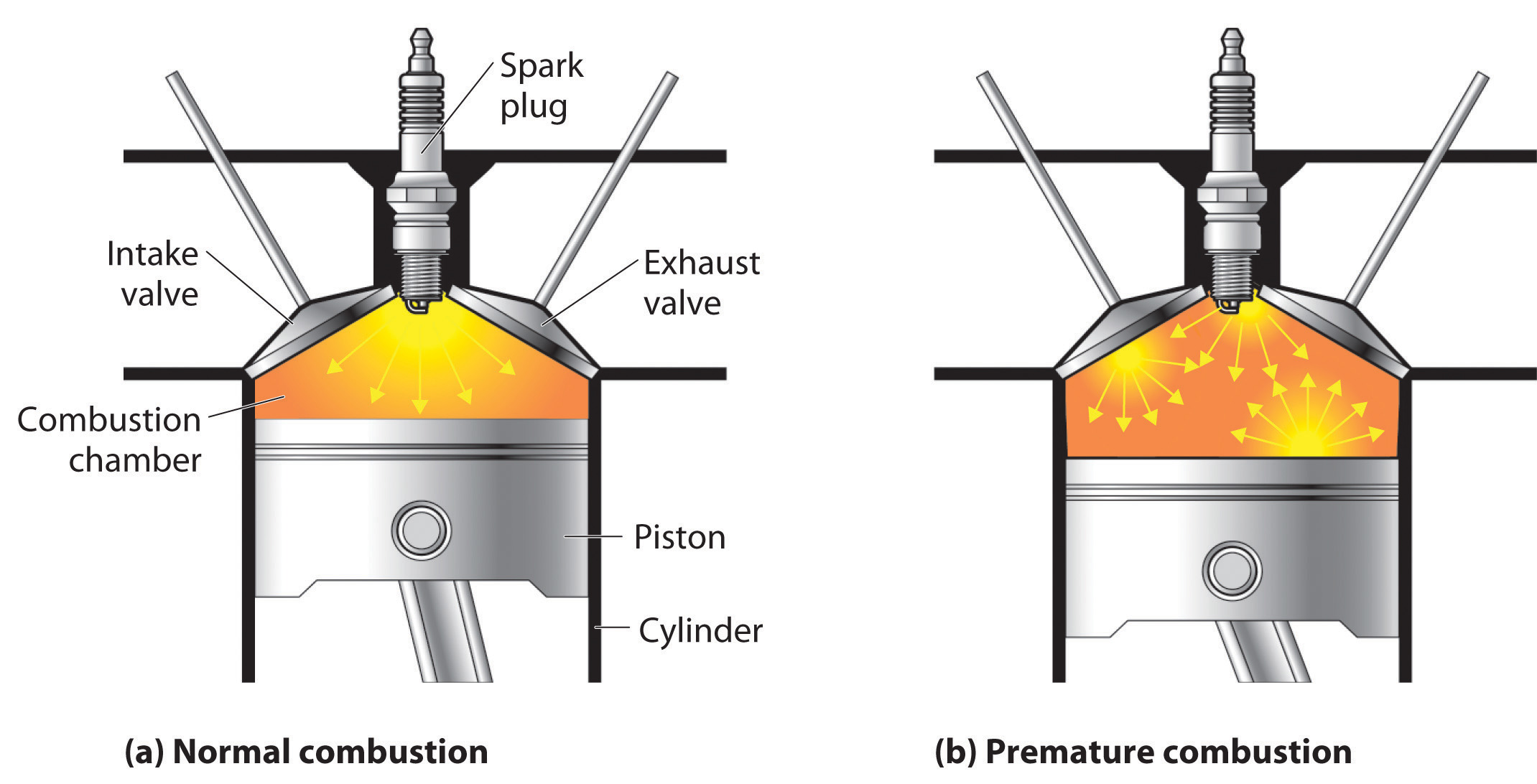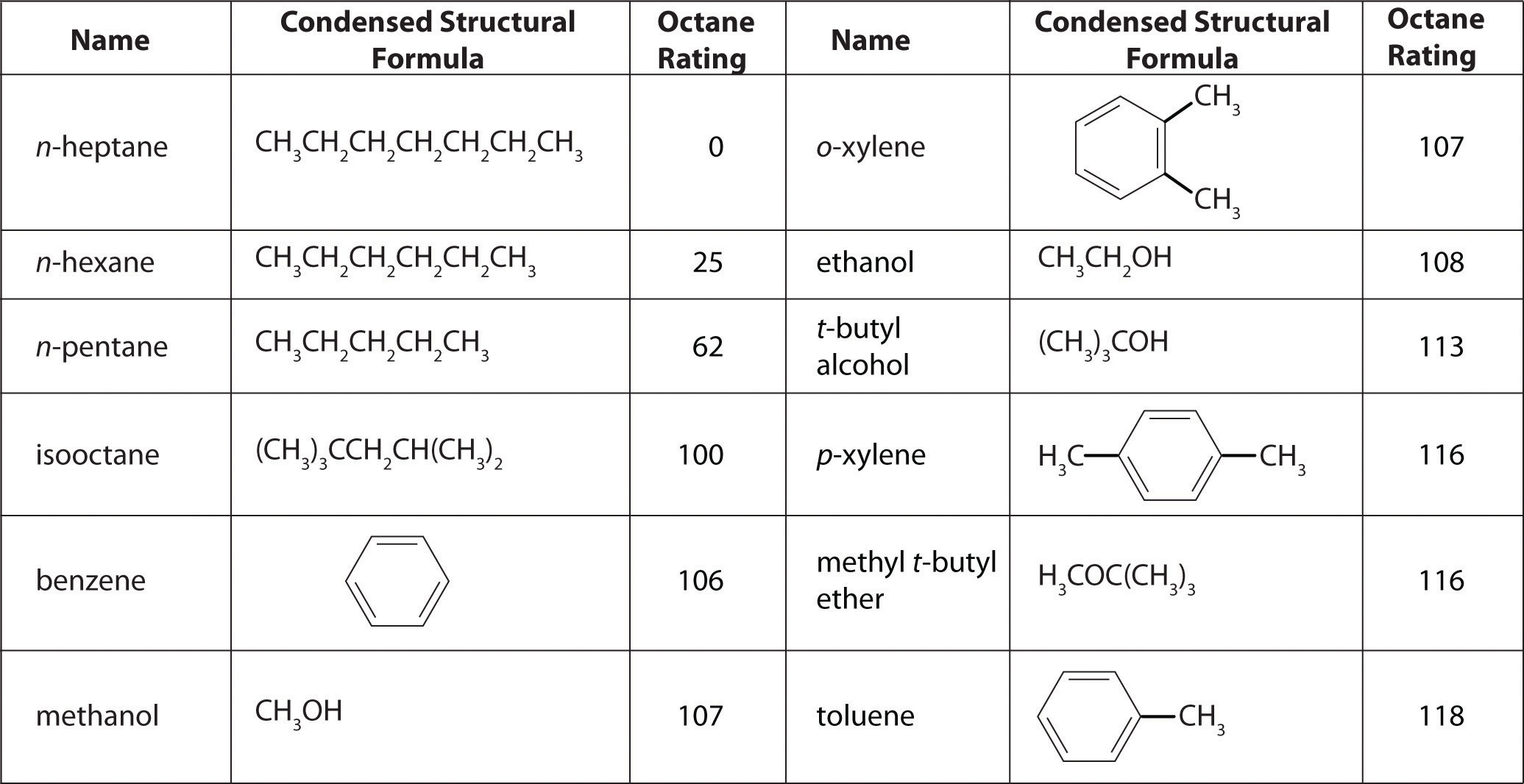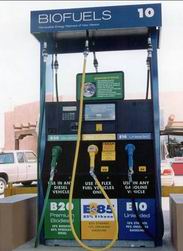15.7: Natural Gas and Petroleum
- Page ID
- 152236
- Describe the nature and processing of natural gas, petroleum, and gasoline.
- List different alternative fuels.
Crude oil is frequently found in reservoirs along with natural gas. In the past, natural gas was either burned or allowed to escape into the atmosphere. Now, technology has been developed to capture the natural gas and either reinject it into the well or compress it into liquid natural gas (LNG).
Natural Gas
Natural gas is predominately composed of methane (CH4). Some of the gases that are produced along with methane, such as butane and propane (by-products), are separated and cleaned at a gas processing plant. The by-products, once removed, are used in a number of ways. For example, propane can be used for cooking on gas grills. Natural gas withdrawn from a well may contain liquid hydrocarbons and non-hydrocarbon gases. This is called "wet" natural gas. The natural gas is separated from these components near the site of the well or at a processing plant. The gas is then considered "dry" and is sent through pipelines to a local distribution company, and, ultimately, to the consumer.
Most of the natural gas consumed in the United States is produced in the United States. Some is imported from Canada and shipped to the United States in pipelines. A small amount of natural gas is shipped to the United States as LNG.
Fracking for Gas
Conventional natural gas is found in permeable reservoirs, typically composed of sandstone or limestone, where extraction is relatively straightforward because the gas generally flows freely. Unconventional gas is found in rocks with extremely low permeability, which makes extracting it much more difficult. Such gas is extracted by employing so-called “unconventional” techniques such as hydraulic fracturing (fracking), which has been in use since the late 1940s. In recent decades, fracking technology has greatly improved, and its use has been expanded. The process of fracking for gas is very similar to that of fracking for oil, and the environmental impacts are similar also.
Petroleum
Petroleum Oil is currently the most widely used fossil fuel and accounts for about one third of global energy consumption. Unlike coal, which is primarily used as a fuel for electricity generation, oil is primarily used as a fuel for transportation. Oil is also used to manufacture plastics and other synthetic compounds ubiquitous to our everyday life. Crude (unprocessed) oil varies greatly in appearance depending on its composition. It is usually black or dark brown (although it may be yellowish, reddish, or even greenish). In the reservoir it is usually found in association with natural gas, which being lighter forms a gas cap over the oil.
Oil is made up of hydrocarbons which are molecules that contain hydrogen and carbon in various lengths and structures, from straight chains to branching chains to rings. Hydrocarbons contain a lot of energy and many of the things derived from crude oil like gasoline, diesel fuel, paraffin wax and so on take advantage of this energy.
Extraction
Oil is mainly obtained by drilling either on land (onshore) or in the ocean (offshore). Early offshore drilling was generally limited to areas where the water was less than 300 feet deep. Oil and natural gas drilling rigs now operate in water as deep as two miles. Offshore oil producers are required to take precautions to prevent pollution, spills, and significant changes to the ocean environment. Offshore rigs are designed to withstand hurricanes. Offshore production is much more expensive than land-based production. When offshore oil wells are no longer productive enough to be economical, they are sealed and abandoned according to applicable regulations.
Processing and Refining
When extracted, crude oil consists of many types of hydrocarbons as well as some unwanted substances such as sulfur, nitrogen, oxygen, dissolved metals, and water all mixed together. Unprocessed crude oil is therefore, not generally useful in industrial applications and must first be separated into different useable products at a refinery (Figure \(\PageIndex{1}\)). All refineries perform three basic steps: separation, conversion, and treatment in the processing and refining of crude oil.
.png?revision=1&size=bestfit&width=590&height=298)
During separation, the various products (hydrocarbons) are separated in to different components (called fractions), by taking advantage of the differences in boiling temperature of the components. This process is called fractional distillation and involves heating up the crude, letting it vaporize and then condensing the vapor. The lightest components have the lowest boiling temperature and rise to the top while the heaviest which also have the highest boiling temperature remain at the bottom.
Conversion is the chemical processing in which some of the fractions are transformed in to other products, for example, a refinery can turn diesel fuel into gasoline depending on the demand for gasoline. Conversion can involve breaking larger hydrocarbon chains into smaller ones (cracking), combining smaller chains into larger ones (unification) or rearranging the molecules to created desired products (alteration).
Treatment is done to the fractions to remove impurities such as sulfur, nitrogen and water among others. Refineries also combine the various fractions (processed and unprocessed) into mixtures to make desired products. For example, different mixtures of hydrocarbon chains can create gasolines with different octane ratings, with and without additives, lubricating oils of various weights and grades (e.g., WD-40, 10W-40, 5W-30, etc.), heating oil and many others. The products are stored on-site until they can be delivered to various markets such as gas stations, airports and chemical plants.
A 42 U.S. gallon barrel of crude oil yields about 45 gallons of petroleum products because of refinery processing gain. This increase in volume is similar to what happens to popcorn when it is popped. Gasoline makes up the largest fraction of all petroleum products obtained (Figure \(\PageIndex{2}\)). Other products include diesel fuel and heating oil, jet fuel, petrochemical feedstocks, waxes, lubricating oils, and asphalt.
.png?revision=1&size=bestfit&width=477&height=404)
Fracking for oil
Hydraulic fracturing, informally referred to as “fracking,” is an oil well development process that typically involves injecting water, sand, and chemicals under high pressure into a bedrock formation via the well. This process is intended to create new fractures in the rock as well as increase the size, extent, and connectivity of existing fractures. Hydraulic fracturing is a well-stimulation technique used commonly in low-permeability rocks like tight sandstone, shale, and some coal beds to increase oil flow to a well from petroleum-bearing rock formations.
There are concerns regarding the potential contamination of fresh groundwater resources from oil and gas extraction wells that use hydraulic fracturing; either from the petroleum resource being produced or from the chemicals introduced in the fracturing process. Fracking fluid flowback – the fluid pumped out of the well and separated from oil and gas – not only contains the chemical additives used in the drilling process but also contains heavy metals, radioactive materials, volatile organic compounds (VOCs) and hazardous air pollutants such as benzene, toluene, ethylbenzene and xylene. In some cases, this contaminated water is sent to water treatment plants that are not equipped to deal with some of these classes of contamination.
Gasoline
Petroleum is converted to useful products such as gasoline in three steps: distillation, cracking, and reforming. Part (a) in Figure \(\PageIndex{3}\ shows a cutaway drawing of a column used in the petroleum industry for separating the components of crude oil. The petroleum is heated to approximately 400°C (750°F), at which temperature it has become a mixture of liquid and vapor. This mixture, called the feedstock, is introduced into the refining tower. The most volatile components (those with the lowest boiling points) condense at the top of the column where it is cooler, while the less volatile components condense nearer the bottom. Some materials are so nonvolatile that they collect at the bottom without evaporating at all. Thus the composition of the liquid condensing at each level is different. These different fractions, each of which usually consists of a mixture of compounds with similar numbers of carbon atoms, are drawn off separately. Part (b) Figure \(\PageIndex{3}\ shows the typical fractions collected at refineries, the number of carbon atoms they contain, their boiling points, and their ultimate uses. These products range from gases used in natural and bottled gas to liquids used in fuels and lubricants to gummy solids used as tar on roads and roofs.
 Figure \(\PageIndex{3}\) The Distillation of Petroleum. (a) This is a diagram of a distillation column used for separating petroleum fractions. (b) Petroleum fractions condense at different temperatures, depending on the number of carbon atoms in the molecules, and are drawn off from the column. The most volatile components (those with the lowest boiling points) condense at the top of the column, and the least volatile (those with the highest boiling points) condense at the bottom.
Figure \(\PageIndex{3}\) The Distillation of Petroleum. (a) This is a diagram of a distillation column used for separating petroleum fractions. (b) Petroleum fractions condense at different temperatures, depending on the number of carbon atoms in the molecules, and are drawn off from the column. The most volatile components (those with the lowest boiling points) condense at the top of the column, and the least volatile (those with the highest boiling points) condense at the bottom.
Octane Ratings of Gasolines
The quality of a fuel is indicated by its octane rating, which is a measure of its ability to burn in a combustion engine without knocking or pinging. Knocking and pinging signal premature combustion (Figure \(\PageIndex{4}\)) which can be caused either by an engine malfunction or by a fuel that burns too fast. In either case, the gasoline-air mixture detonates at the wrong point in the engine cycle, which reduces the power output and can damage valves, pistons, bearings, and other engine components. The various gasoline formulations are designed to provide the mix of hydrocarbons least likely to cause knocking or pinging in a given type of engine performing at a particular level.

The octane scale was established in 1927 using a standard test engine and two pure compounds: n-heptane and isooctane (2,2,4-trimethylpentane). n-Heptane, which causes a great deal of knocking on combustion, was assigned an octane rating of 0, whereas isooctane, a very smooth-burning fuel, was assigned an octane rating of 100. Chemists assign octane ratings to different blends of gasoline by burning a sample of each in a test engine and comparing the observed knocking with the amount of knocking caused by specific mixtures of n-heptane and isooctane. For example, the octane rating of a blend of 89% isooctane and 11% n-heptane is simply the average of the octane ratings of the components weighted by the relative amounts of each in the blend. Converting percentages to decimals, we obtain the octane rating of the mixture:
\[0.89(100) + 0.11(0) = 89 \tag{3.8.1} \]
As given in Table \(\PageIndex{1}\, many compounds that are now available have octane ratings greater than 100, which means they are better fuels than pure isooctane. In addition, antiknock agents, also called octane enhancers, have been developed. One of the most widely used for many years was tetraethyllead [(C2H5)4Pb], which at approximately 3 g/gal gives a 10–15-point increase in octane rating. Since 1975, however, lead compounds have been phased out as gasoline additives because they are highly toxic. Other enhancers, such as methyl t-butyl ether (MTBE), have been developed to take their place. They combine a high octane rating with minimal corrosion to engine and fuel system parts. Unfortunately, when gasoline containing MTBE leaks from underground storage tanks, the result has been contamination of the groundwater in some locations, resulting in limitations or outright bans on the use of MTBE in certain areas. As a result, the use of alternative octane enhancers such as ethanol, which can be obtained from renewable resources such as corn, sugar cane, and, eventually, corn stalks and grasses, is increasing.
Table \(\PageIndex{1}\) The Octane Ratings of Some Hydrocarbons and Common Additives.

Alternative Fuels
Alternative means to power vehicles is a hot topic in environmental chemistry. Hybrid vehicles, ethanol, biodiesel (Figure \(\PageIndex{5}\)), natural gas, and hydrogen fuel cells are all options for powering vehicles that reduce the environmental impact of greenhouse gases in the environment. The main concern for these alternative fuels is their efficiency vs. cost when compared to fossil fuels. Table \(\PageIndex{2}\) shows the chemical structure for several fuels, as well as the energy content of each.

| Gasoline | No. 2 Diesel | Biodiesel | Ethanol | Hydrogen | Liquefied Natural Gas (LNG) | Liquefied Petroleum Gas | |
| Chemical Structure | C4 to C12 | C8 to C25 | Methyl esters of C12 to C22 fatty acids | CH3CH2OH | H2 | CH4 | C3H8 (majority) and C4H10 (minority) |
| Energy Content (Higher Heat Value) | 124,340 Btu/gal (g) | 137,380 Btu/gal (g) | 127,960 Btu/gal for B100 (g) | 84,530 Btu/gal for E100 (g) | 61,013 Btu/lb (g) | 84,820 Btu/gal (g) | 91,410 Btu/gal (g |
| Energy Contained in Various Alternative Fuels as Compared to One Gallon of Gasoline | 100% | 113% | 103% | 77% | 100% | 64% | 73% |
*Table created at: http://www.afdc.energy.gov/afdc/fuels/properties.html
Ethanol
Ethanol can be used in varying percent grades by vehicles. Gasohol is 10% ethanol, produces less carbon emissions than typical gasoline, but decreases the miles per gallon (MPG) of the vehicle slightly. E85 is up to 85% ethanol, can be less expensive depending upon where you live, but lowers the MPG up to 30% compared to typical gasoline. Let’s look at the bond enthalpy change for the burning of fossil fuels vs. the burning of E85 to understand the drop in MPG.
Summary
- The extraction and processing of natural gas (mainly methane) and petroleum oil were discussed.
- Petroleum is converted to useful products such as gasoline by distillation, cracking, and reforming.
- Alternative means to power vehicles and reduce the effect of greenhouse gases in the environment include hybrid vehicles, ethanol, biodiesel , natural gas, and hydrogen fuel cells.
Contributors and Attributions
- Libretext: Introduction to Environmental Science (Zendher et al.)
Dr. Dietmar Kennepohl FCIC (Professor of Chemistry, Athabasca University)
Ed Vitz (Kutztown University), John W. Moore (UW-Madison), Justin Shorb (Hope College), Xavier Prat-Resina (University of Minnesota Rochester), Tim Wendorff, and Adam Hahn.
- US Department of Energy. Alternative Fuels. Retrieved 6/13/2012 from: http://www.fueleconomy.gov/feg/current.shtml
- US Department of Energy. Alternative and Advanced Fuels. Retrieved 6/13/2012 from: http://www.afdc.energy.gov/afdc/fuels/properties.html

